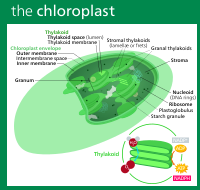
Photo from wikipedia
Photosynthetic efficiency of plants in different environments is controlled by stomata, hydraulics, biochemistry and mesophyll conductance (gm). Recently, gm was demonstrated as the key limitation of photosynthesis in gymnosperms. However,… Click to show full abstract
Photosynthetic efficiency of plants in different environments is controlled by stomata, hydraulics, biochemistry and mesophyll conductance (gm). Recently, gm was demonstrated as the key limitation of photosynthesis in gymnosperms. However, its values across gymnosperms varied over 20-fold, but this variation was poorly explained by robust structure-bound integrated traits such as leaf dry mass per area (LMA). However, understanding how the component structural traits control gm is central for recognizing the determinants of the variability in gm across plant functional and phylogenetic groups. Here we investigated the structural traits responsible for gm in 65 diverse gymnosperms. Although the integrated morphological traits, shape and anatomical characteristics strongly varied across species, the distinguished features of all gymnosperms were thick mesophyll cell walls and low chloroplast area exposed to intercellular airspaces (Sc/S) compared to angiosperms. Sc/S and cell wall thickness were the fundamental traits driving variations in gm across gymnosperm species. Meanwhile, chloroplast thickness was the strongest limitation of gm among liquid phase components. The variation in LMA was not correlated to the key ultrastructural traits determining gm. Thus, instead of integrated easy-to-measure traits, detailed knowledge of underlying component traits controlling gm across plant taxa is necessary to understand the photosynthetic limitations across ecosystems.
Journal Title: Journal of experimental botany
Year Published: 2020
Link to full text (if available)
Share on Social Media: Sign Up to like & get
recommendations!